Take your homemade bread to another level with this authentic Biga Recipe. This versatile 3-ingredient starter adds structure, a subtle tang, and a wonderfully airy crumb to pizza dough, ciabatta, focaccia, and other rustic Italian loaves.
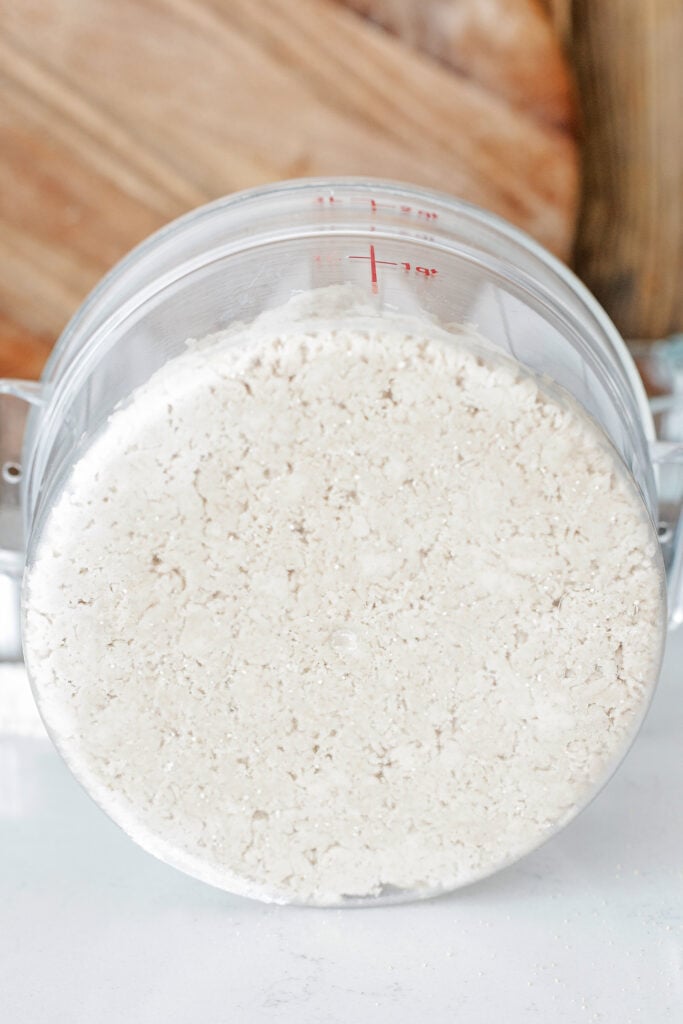
If you’re ready for the rewarding journey of making your bread at home, you should also try my Sourdough Bread and Homemade White Bread. Both recipes are beginner-friendly and leave you with crusty loaves perfect for sandwiches, toast, and more.
What is a Biga?
A biga is a traditional Italian bread starter made with just flour, water, and yeast. This simple pre-fermented dough has been used for generations in Italian baking to help create that slightly tangy, nuanced taste and airy, open crumb that Italian breads and pizzas are known for.
Unlike sourdough starter, a natural yeast levain made only with flour and water, biga uses commercial yeast for predictable results. It also differs from poolish starter, which is wetter and looser, producing softer, slightly more delicate breads like a French boule. Biga’s lower hydration gives bread dough more structure, making it ideal for rustic loaves like ciabatta, focaccia, and chewy pizza crust.
Using a biga is a simple way to elevate your breadmaking: only 3 ingredients and 5 minutes of prep, and you’re well on your way to baking Italian-style breads at home. It’s this small effort that makes a big difference!
Ingredients and Substitutions
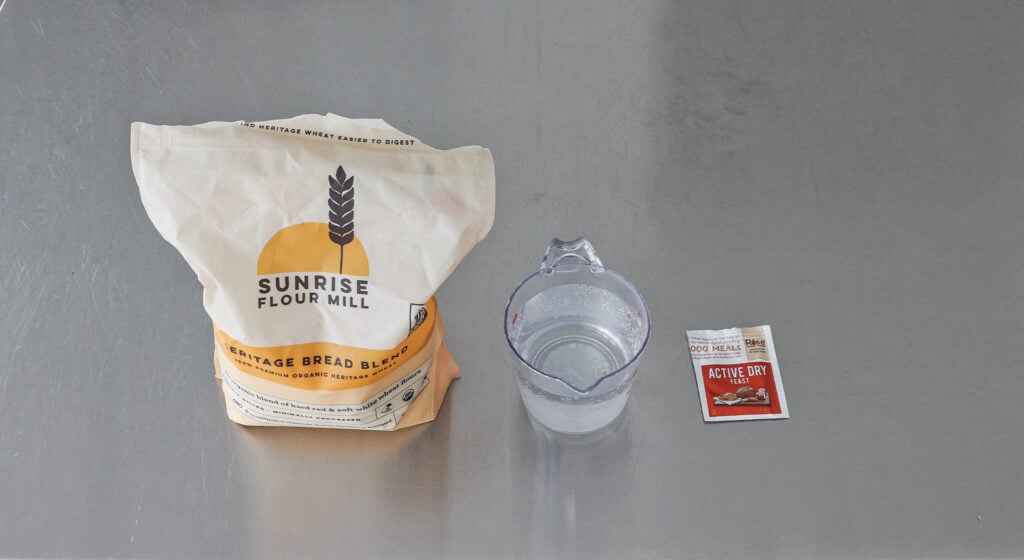
This Italian biga recipe only requires 3 everyday ingredients, but there are specifics you must know about before you start making it:
- Flour – I use bread flour for its higher protein content. All that protein strengthens the biga, resulting in crusty Italian bread with a light and airy crumb. All-purpose flour can be used as a substitute, but the bread’s texture will be slightly softer and less chewy. For a heartier bite, combine AP flour with up to 20% whole wheat or rye flour instead.
- Water – Lukewarm water activates the yeast. I prefer filtered water because tap water can sometimes contain minerals that interfere with yeast activity.
- Yeast – I almost always use active dry yeast for breadmaking. Instant yeast can be used as a substitute, but you’ll need to adjust the rising time accordingly.
- Oil – I use a small amount of olive oil in the bread container to prevent the dough from sticking.
How to Make Italian Biga
Combine: I start by adding the bread flour to a large mixing bowl, followed by the water and yeast. Using my hands, I gently mix and fold everything together until the flour is fully hydrated. I’m not kneading at this stage, but simply bringing the ingredients together until they start to form a dough.
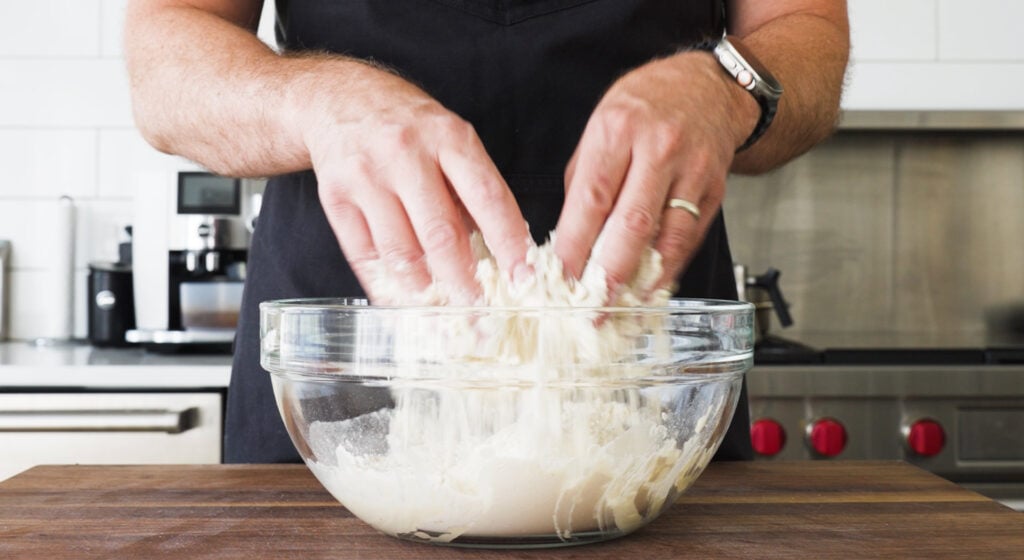
Shaggy stage: The dough will look rough, ragged, and almost stringy now, which is completely normal. Since biga is only hydrated at about 50%, it’s stiffer compared to a typical bread dough. Once I see the dough come together, I shape it into a loose ball.
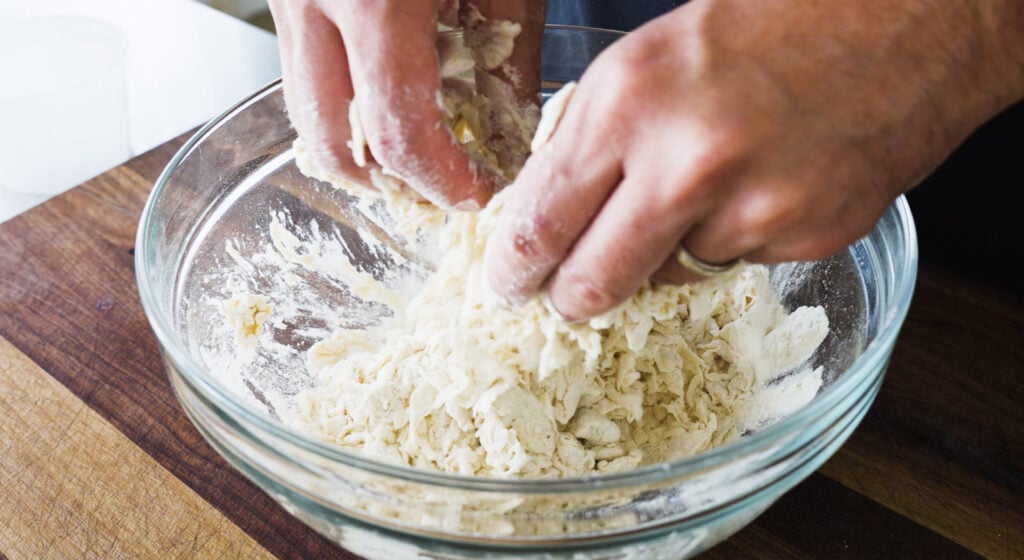
Cover and rest: I transfer the biga to a clear plastic container with a lid so I can see its progress without disturbing it. A light brush of oil inside the container keeps it from sticking.
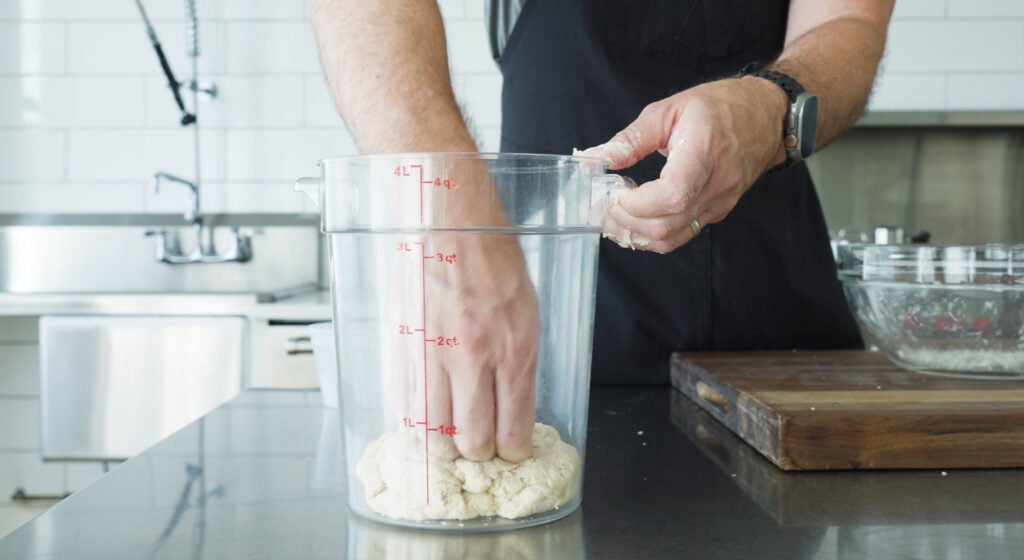
Ferment: I set the biga aside on the kitchen counter for 8 to 24 hours. Afterward, I move it to the fridge to rest for at least 24 hours or up to 72 hours.
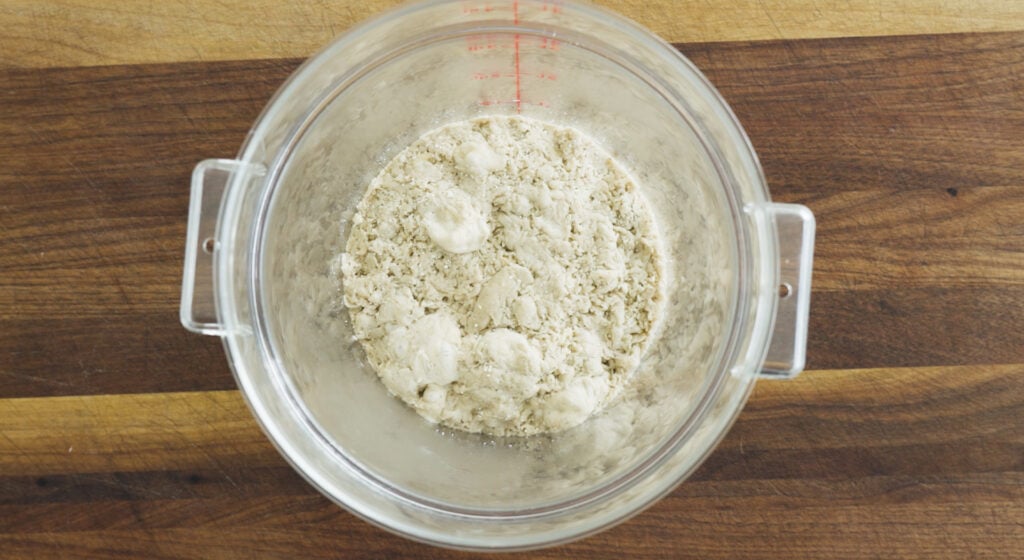
Bake: After it has rested and fermented, my biga is ready to use in any rustic Italian bread or pizza I like.
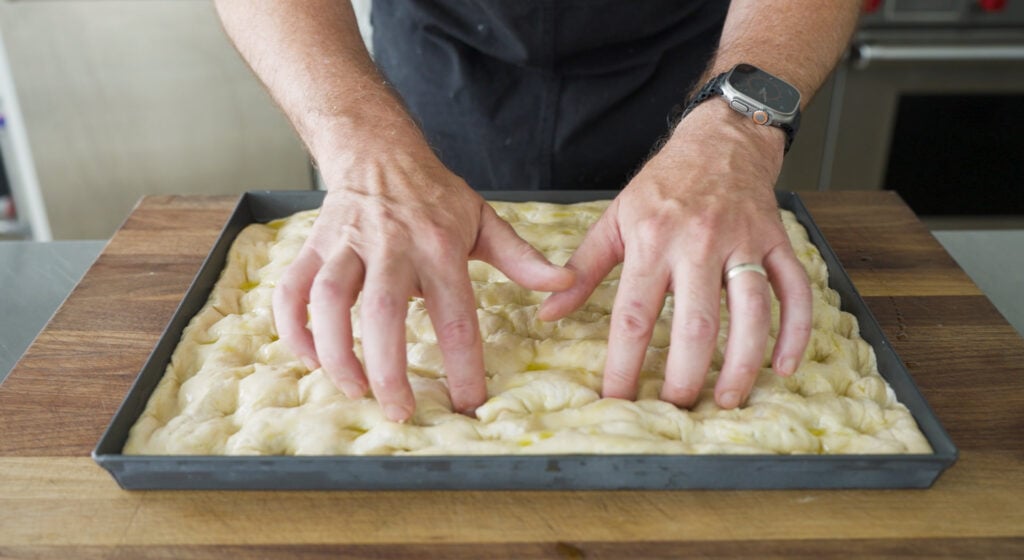

Chef Tip + Notes
Your water temperature can make or break your biga. Think of it this way: yeast is a living ingredient, and lukewarm water (between 105°F and 115°F) is key for its activation and fermentation. Slightly cooler water (between 80ºF and 82ºF) will also work, but this will result in a slower fermentation. When in doubt, opt for water that feels slightly warmer than room temperature, but never hot.
- Troubleshooting a stiff biga: Biga for bread and pizza dough is meant to be on the firm side (about 50% hydration). If it feels dry and crumbly instead of cohesive, you may need to work it a little longer to fully hydrate the flour. A few extra drops of warm water can help, but don’t add too much or else it won’t hold its structure.
- Rising time: Biga should ferment at room temperature (72°F or below) for anywhere between 8 and 24 hours. If your kitchen is warmer, let it rise for 4 to 6 hours, then move it to the fridge for up to 72 hours. The longer it ferments, the more flavor it develops.
- How to tell when it’s ready: A well-proofed biga will look puffy, airy, and slightly domed. If you peek inside the bowl or container, you’ll notice a honeycomb-like network of bubbles—this is your sign that it’s ready to use. If you wait too long, it can become over-proofed and start to collapse.
- If it didn’t rise: First check your yeast, as old or expired yeast may not proof. Also consider your water temperature. Too hot and it can kill yeast; too cold and it will ferment very slowly. If your yeast is fresh and the water temperature is right, give the biga more time—sometimes a slow fermentation just needs patience.
How to Use Biga
I like to use biga for classic Italian bread, such as ciabatta and focaccia. It also works perfectly for pizza dough and my kamut flour bread. I love how it gives these traditional doughs more complexity and extra layers of flavor.
If you’d like to give it a try, use the biga in place of a portion of the flour and water called for in the recipe. It works well with most Italian bread recipes, as well as crusty artisan breads, hamburger buns, and dinner rolls.
Make-Ahead and Storage
Make-Ahead: The biga should be prepared at least 8 hours in advance. It can be left to ferment in its covered container at room temperature during this time.
How to Store: If you’re not ready to bake with it quite yet, keep the biga covered and store it at room temperature for up to 24 hours, in the refrigerator for up to 72 hours, or in the freezer for up to 3 months. Thaw the frozen biga in the refrigerator overnight, then let it come to room temperature before folding it into your dough.
More Homemade Bread Recipes

Biga Recipe
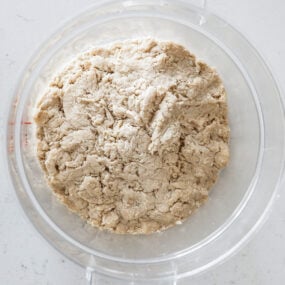
Ingredients
- 2 ¼ cup bread flour, 335 grams of flour
- 2/3 cup + 1 teaspoon filtered lukewarm water, 165 grams
- 1/3 teaspoon active dry yeast, 1 gram
- Olive oil
Instructions
- Add 335 grams of bread flour to a large bowl along with the water and yeast.
- Using your hands, gently mix and fold everything together to combine, which should take you about 3 to 4 minutes.
- Throughout the process of making the biga, the dough will start to become really shaggy, but that’s because it’s only hydrated at 50% and tends to be stiffer.
- Bring the shaggy dough together a bit more to form a sort of loose ball, then transfer it to a plastic container with a lid, or leave it in the bowl covered with plastic. Feel free to brush the container with a little oil.
- It can sit at a room temperature of 72° or less for 8 to 24 hours. If you are above those temperatures, I recommend letting it sit at room temperature for 4 to 6 hours, then placing it in the fridge for 24 hours, and up to 72 hours.
- After the fermenting time, use it in your pizza, ciabatta, or focaccia recipe.

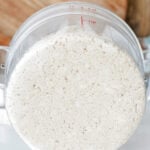
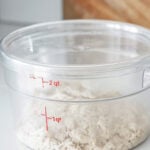
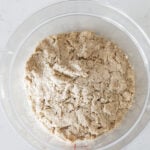
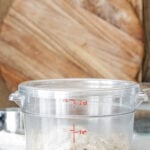
Biga Recipe